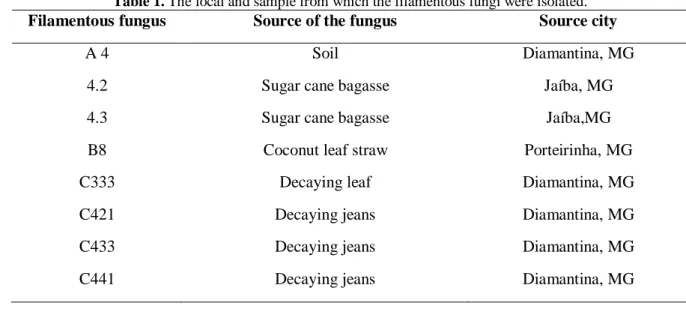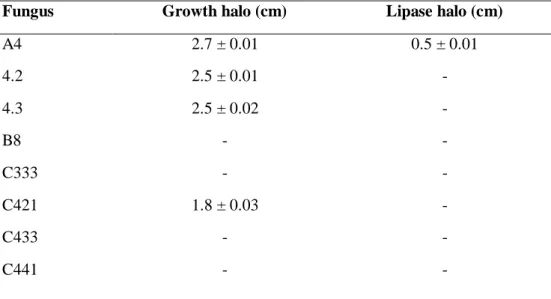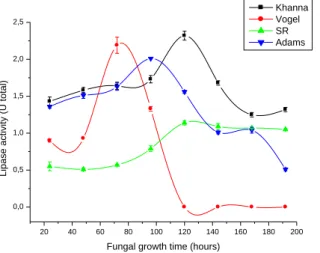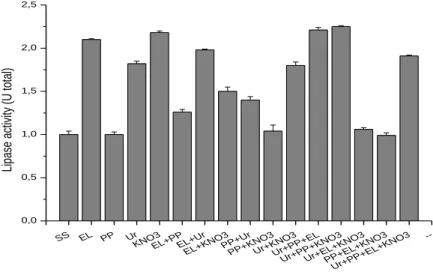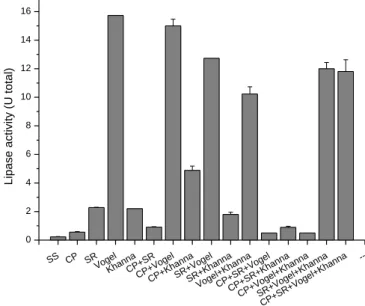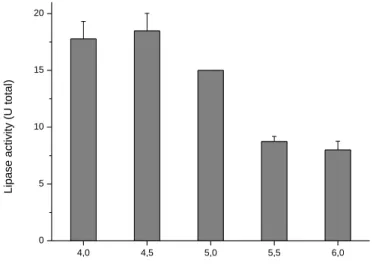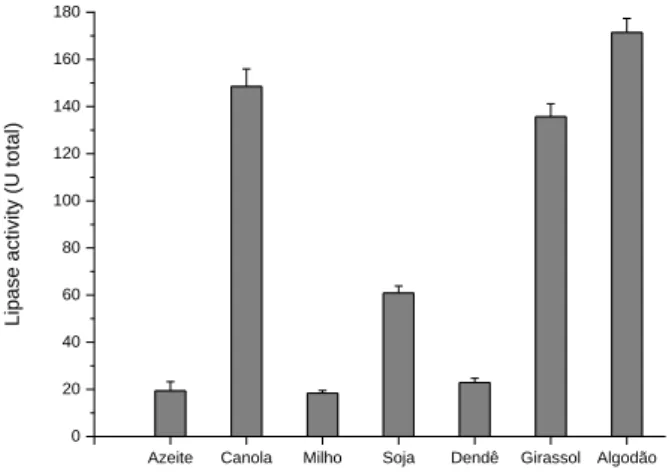Standardization of the cultivation of the isolated filamentous fungus A4 for
lipase production
Padronização do cultivo do fungo filamentoso isolado A4 para a produção de
lipases
DOI:10.34117/bjdv6n10-168
Recebimento dos originais: 05/09/2020 Aceitação para publicação: 08/10/2020
Tatiana P. Costa
Mestre em Biocombustíveis. Universidade Federal dos Vales do Jequitinhonha e Mucuri (UFVJM)
campus JK, Diamantina, MG, Brasil. Rua dos Garimpeiros, número 25, Bairro Centro. CEP
39130-0
tatianaufvjm@hotmail.com
Paula V. D. Spencer
Mestre em Biocombustíveis. Universidade Federal dos Vales do Jequitinhonha e Mucuri (UFVJM) campus JK, Diamantina, MG, Brasil. Rodovia MGT 367 - Km 583, nº 5.000. Alto da Jacuba. CEP
39100-000
paulavillela88@hotmail.com
Mirian J. Souza
Mestre em Biocombustíveis. Universidade Federal dos Vales do Jequitinhonha e Mucuri (UFVJM) campus JK, Diamantina, MG, Brasil. Rua do Progresso, número 262, Bairro. Distrito Senador
Mourão, Diamantina. CEP 39112-000 miriansouzajs@gmail.com
Adeline C. P. Rocha
Mestre em Biocombustíveis. Universidade Federal dos Vales do Jequitinhonha e Mucuri (UFVJM) campus JK, Diamantina, MG, Brasil. Rua Getúlio Vargas, número 409. Bairro Vila Operária. CEP
39100-000 linedtna@hotmail.com
David L. Nelson
Doutor. Universidade Federal dos Vales do Jequitinhonha e Mucuri (UFVJM) campus JK, Professor Visitante do Programa de Pós-Graduação em Biocombustíveis, Diamantina, MG, Brasil.
Rodovia MGT 367 - Km 583, nº 5.000. Alto da Jacuba. CEP 39100-000 dleenelson@gmail.com
Nísia A. V. D. Pinto
Doutora. Docente daUniversidade Federal dos Vales do Jequitinhonha e Mucuri (UFVJM) campus JK, Curso de Nutrição, Faculdade de Ciências Biológicas e da Saúde, Diamantina, MG, Brasil.
Rodovia MGT 367 - Km 583, nº 5.000. Alto da Jacuba. CEP 39100-000 nisia.villela@ufvjm.edu.br
Vivian M. Benassi
Doutora.Docente daUniversidade Federal dos Vales do Jequitinhonha e Mucuri (UFVJM) campus JK, Instituto de Ciência e Tecnologia, Diamantina, MG, Brasil. Rodovia MGT 367 - Km 583, nº
5.000. Alto da Jacuba. CEP 39100-000 vivian.benassi@ufvjm.edu.br
ABSTRACT
Lipases are produced by microorganisms to form an important biotechnological group of enzymes with different properties and specificities. Among the lipase-producing microorganisms are the filamentous fungi, which are abundant and widespread in nature. Because of their catalytic versatility, lipases are highly commercialized, being applied mainly in the production of detergents, food, animal feed, paper and cellulose, pharmaceutical and biodiesel industries. This work sought to select a filamentous fungus that produces lipases and optimize the conditions for cultivation so as to increase lipolytic activity. Initially, 21 filamentous fungi were grown in a solid medium for lipases for four days in a bacteriological incubator at 30 ºC. The fungus with the largest halo representing lipase activity was incubated in five different submerged media at 30 ºC for eight days, and the lipase activity of crude extracellular enzyme extracts was evaluated every 24 hours. After defining the culture medium, its composition was varied, analyzing different sources of nitrogen, salt solutions, the influence of the initial pH of the medium and the carbon source. The isolated fungus, identified as A4, exhibited promising lipase synthesis in Khanna submerged culture medium containing urea, peptone and KNO3 as the nitrogen source, Vogel salts solution, initial pH of 4.5 and cotton oil as a
carbon source. This work demonstrated the importance of standardizing chemical conditions for the growth and production of lipases from filamentous fungi, thereby contributing to a greater understanding of the lipases produced by the selection of the fungus with a potential for enzyme production.
Keywords: Enzymes, Filamentous fungus, Biotechnology RESUMO
Lipases são produzidas por micro-organismos, formando um importante grupo biotecnológico de enzimas com diversas propriedades e especificidades. Dentre os micro-organismos produtores de lipases estão os fungos filamentosos, abundantes e amplamente difundidos na natureza. Devido a sua versatilidade catalítica, as lipases são altamente comercializadas, sendo aplicadas, principalmente, na produção de detergentes, alimentos, ração animal, papel e celulose, indústrias farmacêuticas e biodiesel. Este trabalho objetivou selecionar um fungo filamentoso produtor de lipases e otimizar as condições de cultivo do mesmo, visando o aumento da atividade lipolítica. Inicialmente, 21 fungos filamentosos foram cultivados em meio sólido para lipase durante quatro dias à 30 ºC em estufa bacteriológica. O fungo que apresentou maior halo de atividade de lipase foi incubado em cinco distintos meios submersos à 30 ºC, durante oito dias, sendo avaliada a atividade de lipases dos extratos brutos enzimáticos extracelulares a cada 24 horas. Após definir o meio de cultivo, variou-se sua composição, analisando diferentes fontes de nitrogênio, solução de sais, a influência do pH inicial do meio e a fonte de carbono. O fungo isolado, identificado como A4, foi o que apresentou promissora síntese de lipases em meio de cultura submerso Khanna contendo ureia, peptona e KNO3 como fonte
nitrogenada, solução de sais Vogel, pH inicial 4,5 e óleo de algodão como fonte de carbono. Esse trabalho demostrou a importância da padronização das condições químicas para o crescimento e produção de lipases a partir de fungos filamentosos, contribuindo para um maior entendimento das lipases produzidas pela seleção do fungo com potencial para a produção enzimática.
1 INTRODUCTION
Lipases (EC 3.1.1.3) are classes of hydrolytic enzymes that act as important biotechnological catalysts. They act both at the organic-aqueous interface, catalyzing triglyceride hydrolysis reactions, and in the presence of low concentrations of water. These versatile characteristics make these enzymes highly desirable in various chemical syntheses (BHARATHI and RAJALAKSHMI, 2019; SILA et al., 2020).
Lipases are synthesized by various living organisms, including animal, plant and microbial cells. However, the enzymes of filamentous fungi have many advantages over the other sources mentioned, such as lower production cost, catalytic activity under extreme conditions, enantioselectivity, broad specificity for the substrate and stability in organic solvents, in addition to offering a wide spectrum of physical-chemical characteristics (PEREIRA et al., 2014; FACCHINI et al., 2016; PHUKON et al., 2020).
After proteases and amylases, lipases are considered to be the third most important group of enzymes on the market. This fact is probably related to the attractive versatility of these enzymes for industrial applications, mainly in the production of detergents, food, animal feed, paper and cellulose, and in pharmaceutical and biodiesel industries (KORMAN et al., 2013; ALMEIDA et al., 2020). In the production of biodiesel, factors such as the use of milder reaction conditions, better adaptation to the raw material and reduction in processing steps have made this biocatalysis one of the most widely studied routes to meet the growing demand of this biofuel (LI et al., 2020; ZHONG et al., 2020).
Thus, the wide technological application and specificity of lipases has aroused greater interest in the search for new strains of microorganisms that produce this enzyme. The optimization of cultivation conditions, combined with the choice of appropriate microorganism strains, can lead to greater production of enzymes, in addition to reducing costs, which is extremely advantageous for their commercialization (CARVALHO, 2007). The objective of this work was the selection of a filamentous lipase-producing fungus with interesting characteristics for industrial application, in addition to optimizing the cultivation conditions of the isolated fungus so as to increase the lipolytic activity.
2 MATERIAL AND METHODS
2.1 SELECTION OF FILAMENTOUS-FUNGI-PRODUCING LIPASES IN SOLID CULTURE MEDIUM
Twenty-one filamentous fungi isolated from different materials collected in different locations in the state of Minas Gerais were analyzed. The microorganisms identified as 4.2, 4.3 (SANTOS, 2017), 3.5TA and 3.8TA (ROSA; MARINHO; BENASSI, 2017) were isolated from the sugarcane
bagasse in the city of Jaíba, MG, Brazil. The microorganism identified as B8 was isolated from samples of the coconut leaf straw from the city of Porteirinha, MG, Brazil (SILVA, 2017). The filamentous fungus identified as A4 was isolated from a soil sample in the city of Diamantina, MG, Brazil.
The filamentous fungi identified as EA138 (NOGUEIRA, 2018) and C333 (CARVALHO and SILVA, 2018) were isolated from a decomposing leaf, and the microorganisms identified as C421, C433 and C441 (CARVALHO and SILVA, 2018) were isolated from a fragment of decomposing jeans, all in the city of Diamantina. The microorganism identified as L2 (SILVA, 2018) was isolated from a plum sample; the M1.1, M1.4 and M1.5 fungi were isolated from bark samples, and those identified as M2.3 and M2.5 were isolated from fruit peelings, all located in the city of Janaúba, MG, Brazil (SOUZA, 2017).
The MB2.4, MB2.9 and MB2.12 fungi were isolated from sea water and sand in the Regência district of the city of Linhares, ES, Brazil (OLIVEIRA, 2019). Finally, the fungus identified as P3 was isolated from a moist coconut shell covered with soil in the city of Serranópolis de Minas, MG, Brazil (LOPES, 2017) (Table 1).
The selection of filamentous, lipase-producing fungi utilized the method described by Hankin & Anagnostakis (1975), where all the fungi were punctually inoculated in the center of the Petri dish,in previously sterilized, solid culture medium for lipases containing Potato-Dextrose-Agar (BDA) (20 gL-1), peptone (10 gL-1), sodium chloride (5 gL-1), calcium chloride (2 gL-1) and Tween 80 (10 mL.L-1) incubated in a bacteriological incubator at 30 °C for four days. The radius (cm) of the colony was measured, and the fatty acids released by hydrolysis in Tween 80 were identified by application of 2 mL of the developing solution (0.1 M NaOH and 2 % phenolphthalein) and measuring the halo (cm) of the free fatty acids.
Table 1. The local and sample from which the filamentous fungi were isolated.
Filamentous fungus Source of the fungus Source city
A 4 Soil Diamantina, MG
4.2 Sugar cane bagasse Jaíba, MG
4.3 Sugar cane bagasse Jaíba,MG
B8 Coconut leaf straw Porteirinha, MG
C333 Decaying leaf Diamantina, MG
C421 Decaying jeans Diamantina, MG
C433 Decaying jeans Diamantina, MG
EA138 Decaying leaf Diamantina, MG
L2 Plum Janaúba, MG
MB2.4 Sea sand and water Linhares, ES
MB2.9 Sea sand and water Linhares, ES
MB2.12 Sea sand and water Linhares, ES
M1.1 Tree bark Janaúba, MG
M1.4 Tree bark Janaúba, MG
M1.5 Tree bark Janaúba, MG
M2.3 Fruit peel Janaúba, MG
M2.5 Fruit peel Janaúba, MG
P3 Dirt-covered moist coconut shell Serranópolis de Minas, MG
3.5TA Sugar cane bagasse Jaíba, MG
3.8TA Sugar cane bagasse Jaíba, MG
2.2 MAINTENANCE OF FILAMENTOUS FUNGI
The strains were stored on Dinâmica® silica gel according to the method described by Michelin (2009), where a spore suspension was prepared from 2 mL of powdered milk (200 g.L-1 of autoclaved distilled water). From this suspension, and aliquot of approximately 1 mL was added to test tubes containing 7 g of silica gel and stirred. These tubes were sealed and stored at 4 ºC. The filamentous fungi were cultured in test tubes, 15 cm x 5 cm, containing 4 % Quaker® solid oat medium (w/v) and 2 % Bacteriological Agar (w/v) (EMERSON, 1941), which were incubated in a bacteriological incubator at 30 ºC, and, stored in a refrigerator at 4 ºC after growth of the fungi.
2.3 INOCULUM
The tubes containing the selected filamentous fungus were suspended in 10 mL of previously autoclaved distilled water. One-mL aliquots (616,104 spores) of the spore suspension were inoculated in 125 mL Erlenmeyer flasks containing 25 mL of submerged culture medium.
2.4 OBTAINING MYCELIUM FROM THE FUNGUS AND CRUDE EXTRACELLULAR ENZYME EXTRACT
After the growth of the fungus, the mycelium was separated from the crude enzyme extract by vacuum filtration. After drying, the mycelium was weighed on an analytical balance, and the crude extracts were subjected to the measurement of volume (mL), final pH and lipolytic activity.
2.5 DETERMINATION OF LIPASE ACTIVITY
The reactions were accomplished with 3 mL of the substrate that contained ABC® Olive Oil (Lot: 1712358) and Tween 80 in the proportion of 1:1 (v/v) and 3 mL of the crude enzyme extract. Initially, the tubes containing only the substrate were kept in a water bath at 40 ºC for two minutes. The crude enzyme extract was inserted, and 1-mL aliquots of the mixture were removed at 0 and 15 minutes. The aliquots were poured into 1 mL of acetone:ethanol solution (1:1) to interrupt the reaction. The fatty acids produced were titrated with a standard aqueous solution of 0.02 M NaOH using phenolphthalein indicator. The enzymatic activity was calculated according to Equation 1 (BARON, 2008):
A = ΔVNaOH x [NaOH] (Equação 1)
t x VE
Where:
A = Enzymatic activity (U.mL-1);
ΔV NaOH = Difference in the volume of NaOH (mL) used in the titration in the time of 15 minutes in relation to the volume of time zero;
[NaOH]: NaOH concentration (μmol.mL-1); t: reaction time in minutes (min);
VE: volume of the enzyme solution (mL).
2.6 ANALYSIS OF DIFFERENT CULTURE MEDIA AND GROWTH TIMES OF THE FUNGUS FOR THE PRODUCTION OF LIPASES
The cultures were obtained by inoculating 1 mL of the spore suspension of the selected fungus in 25 mL of the submerged culture media: (1) Adams (ADAMS, 1990); (2) Khanna with modifications of the salt solution by the exclusion of NH4NO3 (KHANNA; SUNDARI; KUMAR,
1995); (3) Vogel with modification of the salt solution by excluding NH4NO3 and Na2MoO4.H2O
and the biotin solution (VOGEL, 1964); and (4) SR modified by the exclusion of NH4H2PO4
(RIZZATTI et al., 2001). All the media contained ABC® Olive Oil as a carbon source. The cultures were kept in a bacteriological incubator for eight days at 30 ºC, and the fungal growth and enzymatic activity were measured every 24 hours to determine the day on which the growth of the microorganism and the production of lipases were the greatest.
2.7 EVALUATION OF THE EFFECT OF DIFFERENT NITROGEN SOURCES ON THE CULTURE MEDIUM FOR THE CULTIVATION OF THE ISOLATED FUNGUS A4 AND THE PRODUCTION OF LIPASES
The selected fungus was grown in modified Khanna medium containing ABC® Olive Oil as a carbon source, and the nitrogen source was varied: 0.1 % yeast extract, 0.1 % peptone, 0.1 % potassium nitrate, 0.1 % urea and their respective combinations. The medium without a nitrogen source was used as a control. The strains were kept in a bacteriological incubator for five days at 30 °C. After the incubation time, the media were filtered to separate the mycelial mass from the extracellular crude extract containing the enzymes.
2.8 EVALUATION OF DIFFERENT SALT SOLUTIONS FROM THE CULTURE MEDIUM FOR THE PRODUCTION OF LIPASES FROM THE ISOLATED FILAMENTOUS FUNGUS A4
The selected fungus was grown in modified Khanna culture medium containing ABC® Olive Oil as a carbon source, and the source of the culture salts was varied. They were 5 mL of Khanna salts solution, 5 mL of SR salts solution, 5 mL of CP salts solution, 5 mL of Vogel salts solution, and the combinations of these solutions. The control did not contain salts. The media were kept in a bacteriological incubator for five days at 30 ºC. After the incubation time, the media were filtered to separate the mycelial mass from the extracellular crude extract containing the enzymes.
2.9 DETERMINATION OF THE IDEAL INITIAL PH OF THE CULTURE MEDIUM FOR THE PRODUCTION OF LIPASES
The initial pH of the modified Khanna culture medium containing a solution of Vogel salts; urea, peptone and KNO3 as a nitrogen source; and ABC® Olive Oil as a carbon source was analyzed
to determine the appropriate pH for the production of lipase. The initial pH of the culture medium was varied from 4.0 to 6.0, with intervals of 0.5. After inoculation of the fungus in the media, they were maintained in a bacteriological incubator for five days at 30 ºC. After incubation, the media were filtered to separate the mycelial mass from the extracellular crude extract containing the enzymes.
2.10 EVALUATION OF THE EFFECT OF DIFFERENT CARBON SOURCES ON THE CULTURE MEDIUM FOR THE PRODUCTION OF LIPASES
The modified Khanna submerged culture media with Vogel salts solution were prepared containing urea, peptone and KNO3 as a nitrogen source and an initial pH of 4.5. The carbon sources
(ABC®), corn oil (Sinhá®), sunflower oil (Sinhá®) and cotton oil (Flor de cotton®). The control was the medium containing ABC® Olive Oil. The growth occurred in a bacteriological oven without stirring at 30 ºC for five days. After incubation, the media were filtered to separate the mycelial mass from the extracellular crude extract containing the enzymes, and the lipolytic activity was determined.
3 RESULTS AND DISCUSSIONS
3.1 SCREENING OF LIPASE-PRODUCING FILAMENTOUS FUNGI
Twenty-one filamentous fungi identified were analyzed for lipase production, and the 16 fungi identified as A4; 4.2; 4.3; C421; EA138; L2; MB2.12; MB2.4; MB2.9; M1.1; M1.4; M1.5; M2.3; M2.5; P3; 3.5TA and 3.8TA grew in the lipase-specific culture medium. However, the strains B8, C333; C441; C433 and 3.8TA did not grow (Table 2).
The lipolytic activity of these microorganisms was determined, and halos of lipase activity were observed only for fungi A4 and M1.1 (.5 cm and 0.3 cm, respectively). Larger growth zones of 6.5 cm, 6.2 cm and 4.6 cm, respectively, were observed for the strains MB2.12, P3 and M2.3. However, no halo of lipolytic activity were obtained (Table 2). The growth of microorganisms in the culture media without the production of extracellular lipases is possibly due to the fact that other nutritional sources favorable to the development of fungi exist in the medium, such as potato starch, dextrose and peptone.
It is known that each species of microorganism produces a characteristic enzyme pool. However, the absolute and relative quantities of these enzymes varies considerably, not only from one species to another, but also between different strains of the same species (MICHELIN, 2009). The isolated fungus A4 was selected for this work.
Table 2. Fungal growth halo (cm) and enzyme halo (cm) produced by filamentous fungi incubated for four days at 30 ºC in a bacteriological incubator in solid culture medium for lipases.
Fungus Growth halo (cm) Lipase halo (cm)
A4 2.7 ± 0.01 0.5 ± 0.01 4.2 2.5 ± 0.01 - 4.3 2.5 ± 0.02 - B8 - - C333 - - C421 1.8 ± 0.03 - C433 - - C441 - -
EA138 3.6 ± 0.01 - L2 2.7 ± 0.01 - MB2.4 4.3 ± 0.01 - MB2.9 4.0 ± 0.02 - MB2.12 6.5 ± 0.02 - M1.1 2.6 ± 0.03 0.3 ± 0.01 M1.4 0.9 ± 0.03 - M1.5 2.3 ± 0.01 - M2.3 4.6 ± 0.01 - M2.5 3.0 ± 0.03 - P3 6.2 ± 0.01 - 3.5TA 1.5 ± 0.02 - 3.8TA - -
The symbol “–” indicates that no growth occurred.
According to Gupta et al. (2003), a screening of lipase-producing microorganisms performed on plates containing solid agar wtith olive oil culture medium is efficient for identifying lipase-producing colonies. Lima (2003), in a similar experiment, selected three fungal strains out of a total of thirty-six, a number close to those observed in our study; and eleven bacterial strains were also selected as lipase producers. Colen, Junqueira and Moraes-Santos (2006) observed that lipolytic halos were obtained for twenty-five of the fifty-nine fungal strains isolated from the Brazilian Savannah, data superior to those observed in our study.
3.2 DETERMINATION OF THE CULTURE MEDIUM FOR THE CULTIVATION OF THE ISOLATED FILAMENTOUS FUNGUS A4 AND ANALYSIS OF THE FUNGAL GROWTH TIME FOR THE PRODUCTION OF LIPASES
Initially, four media were selected to verify the best nutrient composition to induce lipase production. The largest production of lipases by the A4 fungus was observed in the modified Khanna culture medium with a total activity of 2.32 U total on the fifth day of growth, followed by the modified Vogel medium with a total lipolytic activity of 2.19 U on the third day of cultivation of the fungus, and Adams medium with 2.01 U total on the fourth day of cultivation. The lowest enzymatic activity was obtained with the SR medium after five days of cultivation of the A4 fungus with a total activity of 1.14 U at 30 ºC (Figure 1). Therefore, the Khanna medium was chosen to continue the optimization process.
The incubation time of a microorganism has a direct influence on the production of enzymes. Incubation for a short period might not result in maximum production of the enzyme of interest. Likewise, cultivation for a long period can lead to the depletion of nutrients and a decline in enzyme production, in addition to cell death. Thus, each microorganism has its ideal growth time for the production and secretion of lipases, which can also be influenced by the conditions of cultivation and composition of the culture medium (VICI, 2008).
The A4 fungus secreted greater quantities of lipases after five days of cultivation, a result similar to those obtained in the studies by Bancerz, Ginalska and Fiedurek (2005), D’Annibale et al. (2006) and Messias et al. (2009), who cultivated P. chrysogenum, Candida cylindracea and
Botryosphaeria sp, respectively, for the production of lipases. Their results are similar to those
described by Hiol et al. (2000), who recorded four days as the best cultivation time for the production and secretion of lipases from the fungus Rhizopus oryzae in a culture medium containing 4% macerated corn liquor, 1 % peptone, 1.4 % KH2PO4, 0.24 % K3PO4 and 0.04 % MgSO4 at 28 ºC.
In a similar study, Lima et al. (2013) isolated Aspergillus strains from the caatinga soil of the state of Pernambuco and observed a greater production of lipases in a medium composed of olive oil (30 mL.L-1), peptone (70 g.L-1), NaNO3 (1 g.L-1) , KH2PO4 (1 g.L-1), and MgSO4.7H2O (0.5 g.L-1) at
pH 7.0. The maximum lipase production observed by an Aspergillus strain was 22.64 U.mL-1 in 120 hours, whereas another Aspergillus strain produced 26.52 U.mL-1 in 144 hours. Rajendran et al. (2008) optimized the composition of the medium for the production of lipase by Candida rugosa. The medium contained glucose (20 g.L-1), olive oil, peptone and FeCl3.6H2O, and the maximum
lipase activity was 3.8 U.mL-1 in a 50-hour culture at 30 °C, pH 6.8 , with stirring at 120 rpm.
Figure 1. Determination of the culture medium and growth time of the A4 isolated fungus for lipase production.
20 40 60 80 100 120 140 160 180 200 0,0 0,5 1,0 1,5 2,0 2,5 L ip a se a ctiv ity (U to ta l)
Fungal growth time (hours)
Khanna Vogel SR Adams
3.3 DETERMINATION OF NITROGEN SOURCES IN THE CULTURE MEDIUM FOR THE GROWTH OF THE A4 ISOLATED FILAMENTOUS FUNGUS AND ENZYME PRODUCTION
The effects of organic nitrogen sources (urea, peptone and yeast extract) and inorganic nitrogen (potassium nitrate) can be seen in Figure 2. Some extracellular enzymatic activity was observed for all the nitrogen sources analyzed: yeast extract, peptone, potassium nitrate, urea and their combinations.
However, because lipolytic activity (1.00 U total) was even observed for the medium that did not contain a nitrogen source, one could conclude that the fungus does not necessarily depend on a nitrogen source for the synthesis of lipases. However, the insertion of a nitrogen source in the medium increased the activity considerably (Figure 2).
The greatest production of lipases by the A4 fungus was observed in a medium containing peptone, urea and KNO3, with a total activity of 2.25 U total, 7.14 % higher than that of the medium
containing only yeast extract, 3.21 % higher than that obtained with KNO3 as the nitrogen source and
1.8 % greater than that obtained with the combination of urea, peptone and yeast extract (Figure 2). According to studies by Bancerz; Ginalska; Fiedurek (2005), higher levels of lipase activity were obtained with the P. chrysogenum fungus when the microorganism was grown in a medium containing urea as a source of nitrogen, which is about 15 times greater than that obtained when the fungus was grown with yeast extract or peptone. In turn, Lima et. al. (2003) demonstrated that the best source of nitrogen for the production of lipases by P. aurantiogriseum was 1% ammonium sulfate, results different from those seen in our study.
Figure 2. Effect of the nitrogen source on the cultivation of the A4 filamentous fungus in Khanna submerged medium modified for the production of lipases.
SS EL PP Ur KNO3EL+P P EL+U r EL+K NOPP3 +Ur PP+K NO3 Ur+KN O3 Ur+PP +EL Ur+PP +KNO 3 Ur+EL +KNO 3 PP+E L+KN O3 Ur+PP +EL+ KNO3 --0,0 0,5 1,0 1,5 2,0 2,5 Lip ase ac tivi ty (U tota l)
3.4 ANALYSIS OF SALT SOLUTIONS IN THE CULTIVATION OF I A4 FILAMENTOUS FUNGUS FOR LIPASE PRODUCTION
All the sources analyzed exhibited some extracellular enzymatic activity. The production of enzymes in the absence of salts was 0.23 U total; this value was much lower than that of the control medium containing Khanna salts, whose total activity was 2.20 U. This fact suggests that the A4 fungus requires a culture enriched with saline sources to obtain good enzymatic activity (Figure 3).
The greatest production of lipases was observed in medium containing Vogel salt solution (15.73 U total), followed by CP salt solution with Vogel salts (15.00 U total), SR salt solution with Vogel salts (12.73 U total) and SR salt solution with Vogel salts and Khanna salts (12.00 U total). However, the enrichment of the medium with more complex saline sources such as Vogel with CP salts, SR salts and Khanna salts provided a lipolytic activity of 11.81 U total (Figure 3).
Figure 3. Analysis of the influence of different salt sources in the Khanna submerged medium.
SS CP SR Voge l Khan na CP+S R CP+V ogel CP+K hann a SR+V ogel SR+K hann a Voge l+Kha nna CP+S R+Vo gel CP+S R+Kh anna CP+V ogel+ Khan na SR+V ogel+ Khan na CP+S R+Vo gel+K hann a --0 2 4 6 8 10 12 14 16 L ip a se a ctiv ity (U to ta l)
SS- without nitrogen source; EL- yeast extract; PP- Peptone; Ur-Urea.
In a similar study, Tan et al. (2003) studied the production of lipase by Candida sp in fermentation media using nitrogen, carbon and ion sources. After optimization, the production of l8,060 U.mL-1 of lipase in a fermenter (1500 L) was obtained using medium composed of 4 % soy bran, 2.5 % soy oil, 0.1 % K2HPO4, 0.1 % (NH4)2SO4, and 0.05 % MgSO4, at pH 7.0. The authors
observed that the inclusion of Mg2+, Na+ and K+ were beneficial for the biosynthesis of lipase, whereas the formation of complexes with fatty acids occurred with the Ca2+ ion, changing their solubility and the behavior at the oil/water interface and inhibiting lipase synthesis. Ramani et al. (2010) realized that, with the addition of some metal ions (K+, Na+, Fe2+ and Mg2+) to the culture
medium, a slight inhibition of the production of lipase by Pseudomonas gerssadii was observed. A stimulating effect on the production of lipase was observed with the Ca2+ ion. The choice of culture
conditions, in particular the chemical composition of the medium and the sources of carbon and nitrogen, are important factors for the production of lipase (DALMAU et al., 2000; OLIVEIRA et al., 2013).
3.5 DETERMINATION OF THE INITIAL PH FOR THE CULTIVATION OF THE A4 FILAMENTOUS FUNGUS FOR LIPASE PRODUCTION
The greatest production of lipase was obtained with the A4 fungus in the pH range 4 to 5, the greatest production of lipases occurred at pH 4.5 and the lowest at pH 6.0. It was found that the initial pH influenced the production of lipases, and the greatest production occurred in a more acidic range. The total lipolytic activity observed with the A4 fungus was 18.48 U in Khanna medium containing Vogel salts with an initial pH of 4.5. This value was approximately 23 % higher than that obtained for the control medium (pH 5.0) and 4 % higher than that obtained in the medium at pH 4.0 (Figure 4).
Figure 4. Effect of the initial pH on the cultivation of the A4 filamentous fungus in a submerged Khanna medium.
4,0 4,5 5,0 5,5 6,0 0 5 10 15 20 Lipase act ivit y (U t ot al)
The pH is a physical requirement that affects the growth of the fungus because it can influence the availability of certain metal ions. These ions can form complexes that become insoluble at certain pH ranges (FERREIRA et al., 2016).
When the fungus is growing, its metabolism alters the pH, either by the absorption of anions or cations or by the production of organic acids or ammonia. During cultivation, buffering is difficult, as the buffers themselves can be assimilated, or they can be toxic in quantities that would be necessary for effective buffering (COLEN, 2006).
In a similar study, Ferreira et al. (2016) determined the influence of pH on the growth of the
Pycnoporus sanguineus and Trametes sp fungi and observed a greater growth of both fungi in the 5
to 7 pH range. The maximum growth occurred in the range of 5 to 6. Castro and Silva (1996) also observed a similar effect of pH for the fungi Antrodia albida and Tyromyces sp, which preferred a low pH range of 5 to 8. The optimum pH was 6.
3.6 OPTIMIZATION OF THE CARBON SOURCE OF THE CULTURE MEDIUM FOR LIPASE PRODUCTION
Among the seven types of lipid sources used at a concentration of 1 %, the greatest production of lipases by the A4 fungus was obtained using cotton oil (171.36 U total), followed by canola oil (148.38 U total) and sunflower oil (135.62 U total) (Figure 5). Thus, the enzymatic activity of the culture medium supplemented with cotton oil was approximately 45 % greater than the activity in the medium containing olive oil as a carbon source. Smaller lipase production was obtained using corn oil, olive oil and palm oil, and the following enzymatic activities were observed: 18.39 U total, 19.33 U total and 22.88 U total, respectively (Figure 5).
Figure 5. Analysis of the action of different carbon sources in inducing the production of lipases by the A4 filamentous fungus.
Azeite Canola Milho Soja Dendê Girassol Algodão
0 20 40 60 80 100 120 140 160 180 Lipa se a cti vi ty (U total )
These results can be related to the chemical composition of the oils and the fact that lipases preferentially hydrolyze the fatty acid residues in positions 1 and 3 of glycerides. Also, some extracellular lipases requires oleic acid as a stabilizer or activator (MAFAKHER et al., 2010). Oils of different origins have different fatty acid compositions, as well as different concentrations of the same lipids (VICI, 2008).
Several authors report the production of lipases by fungi and bacteria in submerged culture supplemented with olive oil, and some studies mention palm oil, Tween 20 and 40, triolein, tripalmitin, soybean oil, cotton oil, sunflower oil and corn oil as carbon sources for the production of microbial lipases.
The fungus A. niger exhibited a higher specific activity when grown in a medium supplemented with sesame oil, sunflower oil and palm oil, whereas greater growth of the fungus Penicillium
purpurogenum was obtained in macauba oil, soybean oil and sunflower oil (VICI, 2008), These
results are different from those observed in our study. Growth in various vegetable oils, including babassu, canola, cotton, sunflower and olive oil, was observed for several isolates of Botryosphaeria
spp. (MESSIAS et al., 2009). In a similar study, Lima et al. (2003) studied the use of olive, soybean,
corn and sunflower oils, and obtained a greater production of lipases by P. aurantiogriseum with olive oil.
Bancerz, Ginalska and Fiedurek (2005) performed an experiment similar to that of this work for the fungus P. chrysogenum and obtained a better result using corn oil, olive oil or triolein as the source for lipase production. D’Annibale et al. (2006) studied the effect of adding olive oil, corn oil and soy oil to the culture medum for C. Cylindracea, and they observed greater production of lipases in medium supplemented with olive oil.
Colin, Baigori and Pera (2010) also obtained greater production of lipases by A. niger MYA135 using olive oil than with grape, soy, corn and sunflower oils. Messias et al. (2009) obtained better production of lipases by Botryosphaeria ribis in medium supplemented with oleic acid.
4 CONCLUSIONS
This work demonstrated the importance of standardizing the physical and chemical conditions of the culture medium for the growth and production of lipases from the isolated filamentous fungus A4, and submerged fermentation in the Khanna culture medium with the combination of urea, peptone and KNO3 as a source of nitrogen, with the solution of Vogel salts, and cotton oil as a source
of carbon at an initial pH of 4.5 were defined as the ideal conditions. The optimization of the conditions proved to be necessary because it resulted in an increase in the yield of lipases produced by the fungus A4. Therefore, the present study was very representative because it enabled the selection of strains with a potential for the production of lipases.
ACKNOWLEDGMENTS
The authors thank the Federal University of the Jequitinhonha and Mucuri Valleys (UFVJM). This work was registered in the National System for the Management of Genetic Heritage and Associated Traditional Knowledge (SisGen), number A64AD93.
REFERENCES
ADAMS, P.R. Mycelial amylase activities of thermophilic species of Rhizomucor, Humicola and
Papulaspora. Mycopathologia, v. 112, p 35-37, 1990.
ALMEIDA, J. M., ALNOCH, R. C., SOUZA, E. M., MITCHELL, D. A., & KRIEGER, N. Metagenomics: Is it a powerful tool to obtain lipases for application in biocatalysis?. Biochimica
et Biophysica Acta (BBA)-Proteins and Proteomics, v. 1868, n. 2, p. 140320, 2020.
BANCERZ, R.; GINALSKA, G.; FIEDUREK, J.; GROMADA, A. Cultivation conditions and properties of extracellular crude lipase from the psychrotrophic fungus Penicillium chrysogenum 9’.
J. Ind. Microbiol. Biotechnol., v. 32, p. 253- 260, 2005.
BARON, A.M. Preparação e caracterização de lipases imobilizadas para utilização em
biocatálise. Tese (Doutorado em Química) – Universidade Federal do Paraná, 2008.
BHARATHI, Devaraj; RAJALAKSHMI, G. Microbial lipases: An overview of screening, production and purification. Biocatalysis and Agricultural Biotechnology, p. 101368, 2019.
CARVALHO E SILVA, C. H. Coleta, isolamento e análise termofílica de fungos filamentosos isolados no lixão da UFVJM – Campus JK. Trabalho de conclusão de curso, 2018.
CARVALHO, S. Pectinases produzida pelo agente biológico G088: extração e purificação. 2007. 100p. Dissertação (Mestrado em Ciências dos Alimentos) – Universidade Federal de Lavras, Lavras, MG.
CASTRO E SILVA, A. Micromorfologia da Degradação de Madeira da espécie Amazônica Hura creptans L. por fungos ligninolíticos pertencentes a classe Hymenomycetes (Tese de Doutorado). Manaus: INPA/FUA. 1996.
COLEN, G.; JUNQUEIRA, R.G.; MORAES-SANTOS, T. Isolation and screening of alkaline lipaseproducing fungi from Brazilian savanna soil. World J. Microbiol. Biotechnol., v.22, n. 8, p. 881-885, 2006.
COLIN, V.L.; BAIGORI, M.D.; PERA, L.M. Effect of environmental conditions on extracellular lipases production and fungal morphology from Aspergillus niger MYA 135. J. Basic Microbiol., v. 50, p. 52-58, 2010.
DALMAU, E. et al. Effect of different carbon sources on lipase production by Candida rugose. Enzyme and Microbial Technology, v. 26,p. 657–663, 2000.
D’ANNIBALE, A.; SERMANNI, G.G., FEDERICI, F.; PETRUCCIOLI, M. Olive-mill wastewaters: a promising substrate for microbial lipase production. Bioresour. Technol., v. 97, p. 1828-1833, 2006.
EMERSON, R. An experimental study of the life cycles and taxonomy of Allomyces. Lloydia, 4:77-144, 1941.
FACCHINI, F. D. A., VICI, A. C., PEREIRA, M. G., DE OLIVEIRA, M. F., BATISTA, A. C. F., VIEIRA, A. T., & POLIZELI, M. L. T. M. A useful methodology to select lipase-catalyzed transesterification aiming biodiesel application. Revista Brasileira de Engenharia de Biossistemas, v. 10, n. 1, p. 01-13, 2016.
FERREIRA, F. S., BATISTA, I. H., FERREIRA, A. S., ALBUQUERQUE, C. C., CASTRO E SILVA, A. Otimização das condições de crescimento de fungos degradadores de madeira. Revista
Científica de Estudos Superiores de Parintins, 2016.
GUPTA, R.; RATHI, P.; GUPTA, N; BRADOO, S. Lipase assays for conventional and molecular screening: an overview. Biotechnol. Appl. Biochem., v. 37, p. 63-71, 2003.
HANKIN, L.; ANAGNOSTAKIS, S. L. The use of solid media for detection of enzymes production by fungi. Mycologia, New York, v. 67, n. 3, p. 597-607, Nov/Dec. 1975.
HIOL, A.; JONZO, M.D.; RUGANI, N.; DRUET, D.; SARDA, L.; COMEAU, L.C. Purification and characterization of an extracellular lipase from a thermophilic Rhizopus oryzae strain isolated from palm fruit. Enzyme Microbial. Technol., v. 26, p. 421-430, 2000.
KHANNA, P.; SUNDARI, S.S; KUMAR, N.J. Production, isolation and partial purification of xylanase from Aspergillus sp. World J. Microbiol. Biotechnol., v.11, p 242-243, 1995.
KORMAN, T.P.; SAHACHARTSIRI, B.; CHARBONNEAU, D.M.; HUANG, G.L.; BEAUREGARD, M.; BOWIE, J.U. Dieselzymes: development of a stable and metanol tolerant lipase for biodiesel production by directed evolution. Biotechnology for biofuels, v. 6, n. 1, 2013.
LI, J., ZHANG, J., SHEN, S., ZHANG, B., & WILLIAM, W. Y. Magnetic responsive Thermomyces lanuginosus lipase for biodiesel synthesis. Materials Today Communications, p. 101197, 2020.
LIMA, V.M.G.; KRIEGER, N.; SARQUIS, M.I.M.; MITCHELL, D.A.; RAMOS, L.P.; FONTANA, J.D. Effect of Nitrogen and Carbon Sources on Lipase Production by Penicillium aurantiogriseum.
Food Technol. Biotechnol., v. 41, n. 2, p. 105-110, 2003.
LIMA, B.F.; CORREIA, M. A. B.; SANTOS CORDEIRO,; ANDRADE SILVA, N.R.; SÁ MUNIZ, M. C.; AMORIM, H. S.; LIMA, J. M. M.; ALVES DA SILVA,C.A. Seleção de meios de produção de lipase por Aspergilluss sp. Resumos expandidos do I conicbio / II conabio / VI simcbio (v.2), Recife/PE, 2013.
LOPES, P. H. S. Produção de β-D-frutofuranosidases pelo fungo filamentoso Aspergillus sp. P4 isolado no norte de Minas Gerais. Trabalho de conclusão de curso, 2017.
MAFAKHER, L.; MIRBAGHERI, M.; DARVISHI, F.; NAHVI, I.; ZARKESH-ESFAHANI, H.; EMTIAZI, G. Isolation of lipase and citric acid producing yeasts from agro-industrial wastewater. New Biotechnology. Vol 27, 2010.
MESSIAS, J.M.; COSTA, B.Z.; LIMA, V.M.G.; DEKKER, R.F.H.; REZENDE, M.I.; KRIEGER, N.; BARBOSA, A.M. Screening Botryosphaeria species for lipases: Production of lipase by
Botryosphaeria ribis EC-01 grown on soybean oil and other carbono sources. Enzyme Microb.
Technol., v. 45, p. 426-431, 2009.
MICHELIN, M. Potencial dos fungos Aspergillus terricola e Aspergillus ochraceus no desenvolvimento de bioprocessos e propriedades das enzimas xilanolíticas. Ribeirão Preto, 2009. Tese (Doutorado em Ciências, Área: Biologia Comparada) – Faculdade de Filosofia, Ciências e Letras de Ribeirão Preto – USP.
NOGUEIRA, E. A. Análise de características de fungos filamentosos prospectados no lixão da UFVJM campus JK, Diamantina, MG. Trabalho de conclusão de curso, 2018.
OLIVEIRA, A. C. D.; VARGAS, J. V. C.; RODRIGUES, M. L. F.; MARIANO, A. B. Utilização de resíduos da agroindústria para a produção de enzimas lipolíticas por fermentação submersa. Revista Brasileira de Produtos Agroindustriais, Campina Grande, v.15, n.1, p.19-26, 2013.
OLIVEIRA, M. M. C. Isolamento de fungos filamentosos obtidos de amostras do rio doce e do mar coletada em Regência, município de Linhares, estado do Espírito Santo, e padronização do cultivo do micro-organismo MB2.7 para a produção de lipases. Trabalho de conclusão de curso, 2019.
PEREIRA, M. G., VICI, A. C., FACCHINI, F. D. A., TRISTÃO, A. P., CURSINO-SANTOS, J. R., SANCHES, P. R., & POLIZELI, M. D. L. T. D. M. Screening of filamentous fungi for lipase production: Hypocrea pseudokoningii a new producer with a high biotechnological potential. Biocatalysis and Biotransformation, v. 32, n. 1, p. 74-83, 2014.
PHUKON, L. C., CHOURASIA, R., KUMARI, M., GODAN, T. K., SAHOO, D., PARAMESWARAN, B., & RAI, A. K. Production and characterisation of lipase for application in detergent industry from a novel Pseudomonas helmanticensis HS6. Bioresource Technology, p. 123352, 2020.
RAJENDRAN, A.; PALANISAMY, A.; THANGAVELU, V. Evaluation of medium components by plackett-burman statistical design for lipase production by cândida rugosa and kinetic modeling. Chinese journal of biotechnology. vol 24, Issue 3, 2008.
RAMANI, K.; JOHN KENNEDY, L.; RAMAKRISHNAN, M.; SEKARAN, G. Purification, characterization and application of acidic lipase from Pseudomonas gessardii using beef tallow as a substrate for fats and oil hydrolysis. Process Biochemistry 45, 1683–1691, 2010.
RIZZATTI, A.C.S.; JORGE, J. A.; TERENZI, H.F.; RECHIA, C.G.V.; POLIZELI, M.L.T.M. Purification and properties of a thermostable extracellular-D-xylosidase produced by thermotolerant
Aspergillus phoenicis. J. Ind. Microbiol. Biotechnol., v.26, p. 96-100 156-160, 2001.
ROSA, T. M. F.; MARINHO, B. M.; BENASSI, V. M. Produção de celulases e formação de açúcares fermentescíveis pela degradação do bagaço de cana-de-açúcar. Ciência & Tecnologia: FATEC-JB, Jaboticabal (sp), v. 9, n. 1, p. 38-43, 2017.
SANTOS, A. M. A., Produção de celulases a partir de fungos filamentosos cultivados em meio contendo resíduos de bananeira. Trabalho de conclusão de curso, 2017.
SILVA, M. T. Produção de β-D-frutofuranosidases por Aspergillus sp. MT2.4. Trabalho de
conclusão de curso, 2017.
SILVA, L. T. A. Produção e caracterização bioquímica de amilases produzidas por Penicillium sp. L1 isolado em Janaúba – MG. Trabalho de conclusão de curso, 2018.
SILVA, M. D.; ERNANDES, F. M. P. G; CRUZ, C. H. G. Selection and isolation of fungi strains and the use of banana peel a suport for lipases production. Braz. J. of Develop., Curitiba, v. 6, n. 7, p. 51310-51320, 2020.
SOUZA, M. T. S. Prospecção de fungos filamentosos e produção de amilases por Aspergillus sp. M1.7.2. Trabalho de conclusão de curso, 2017.
TAN, T.; ZHANG, M.; WANG, B.; YING, C.; DENG, L. Screening of high lipase producing Candida sp. and production of lipase by fermentation. Process Biochemistry 39,459/465, 2003.
VICI, A. C. – Estudos de lipases produzidas pelos fungos Ascomycota Aspergillus niger, Cordyceps
brongniartii e Penicillium purpurogenum. Monografia apresentada a Faculdade de Filosofia Ciências
e Letras de Ribeirão Preto, para a obtenção do título de Bacharel em Ciências Biológicas, USP, 2008.
VOGEL, H.F. Distribution of lysine pathways among fungi: evolutionary implications. Am. Nat., v. 98, p. 435-446, 1964.
ZHONG, L., FENG, Y., WANG, G., WANG, Z., BILAL, M., LV, H., & CUI, J. Production and use of immobilized lipases in/on nanomaterials: A review from the waste to biodiesel production. International Journal of Biological Macromolecules, 2020.
